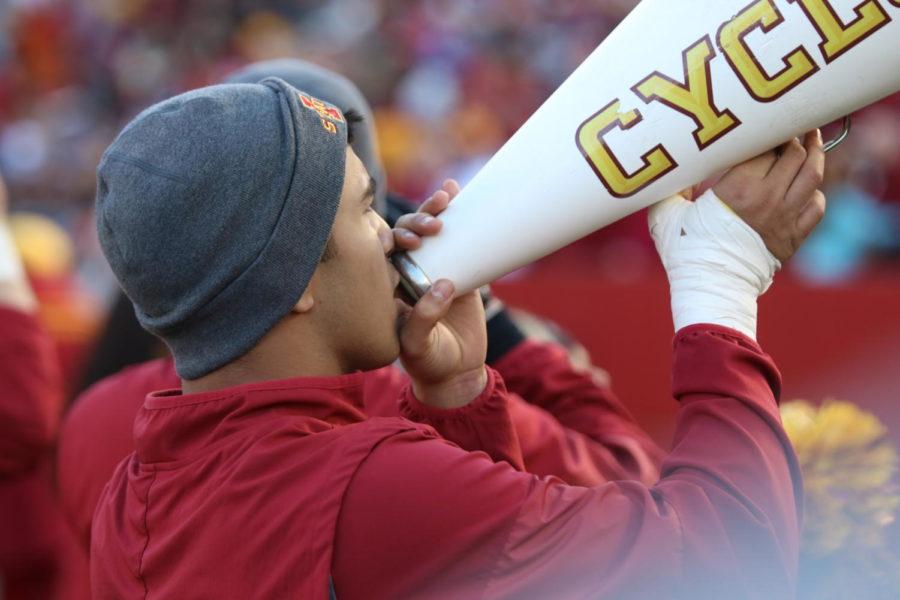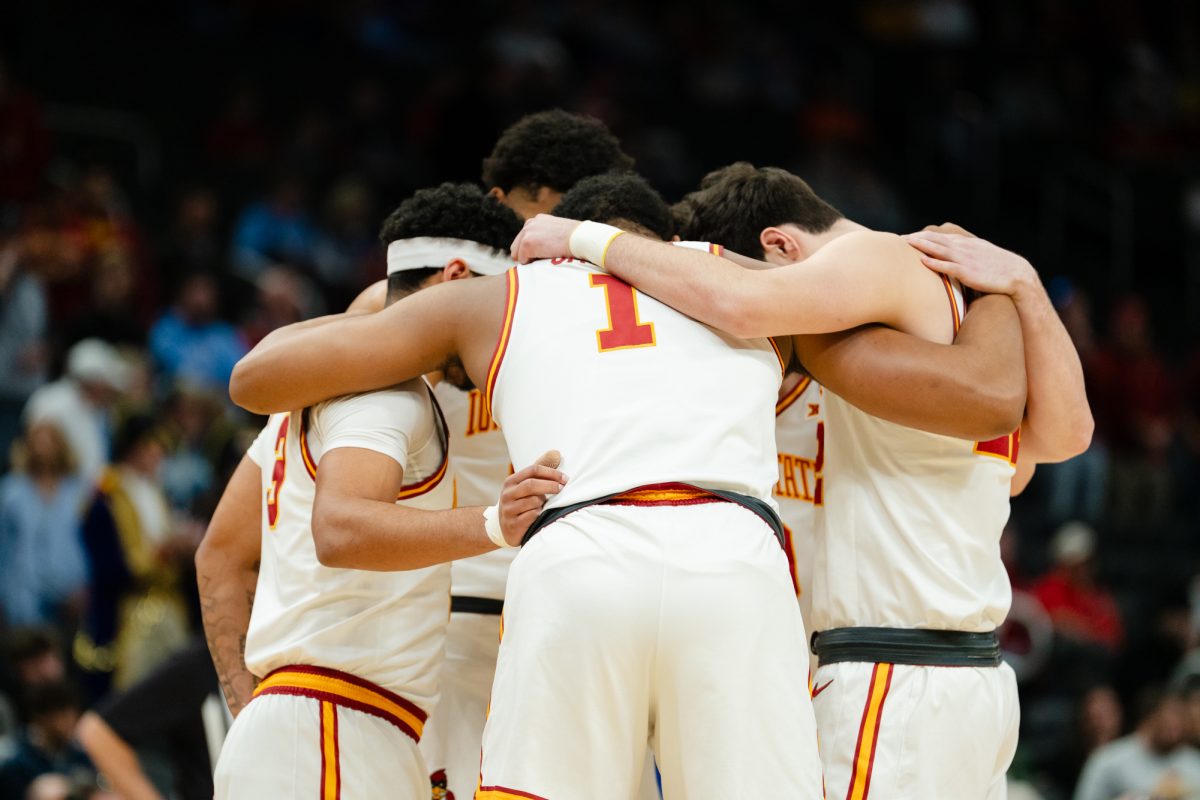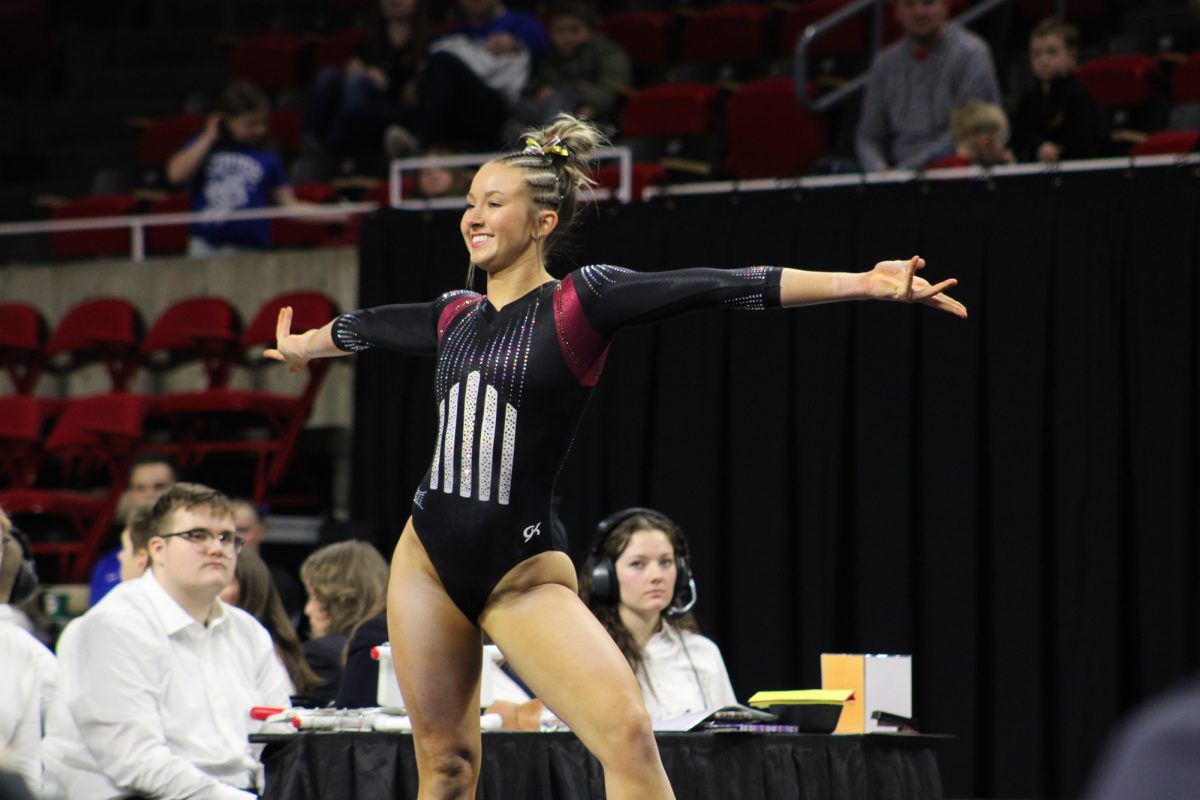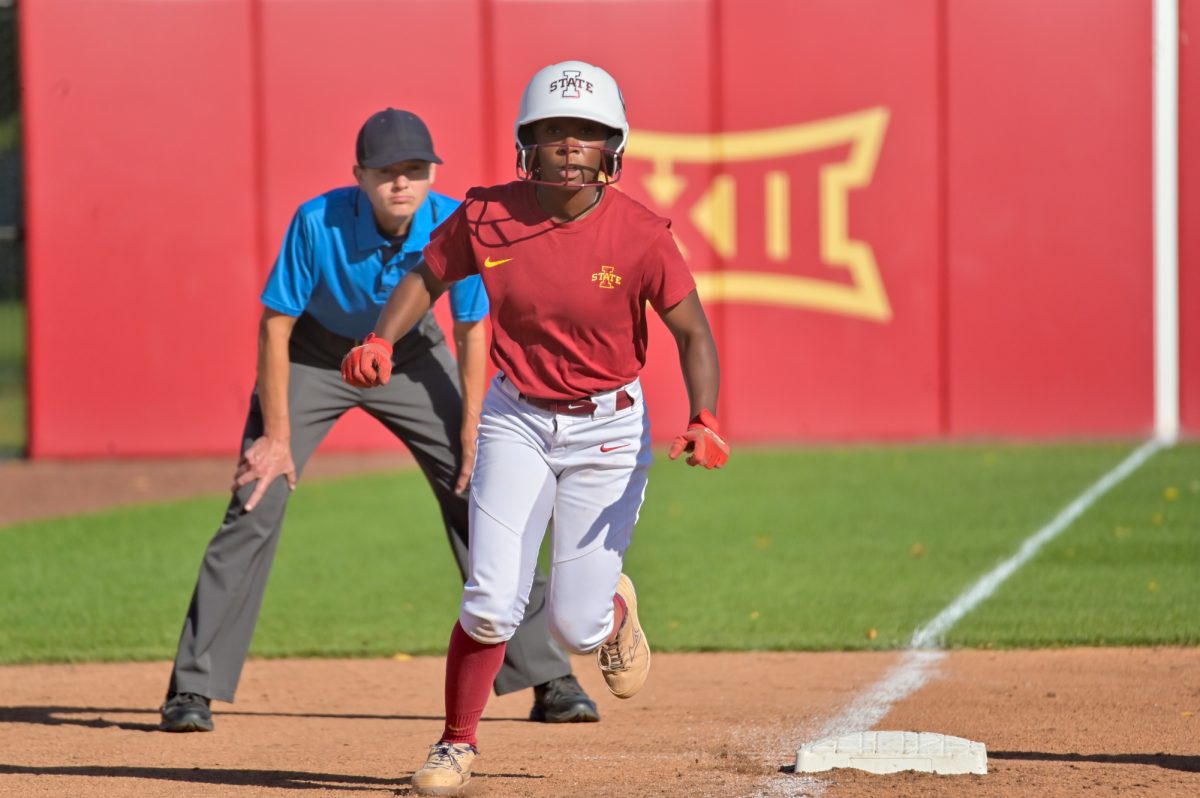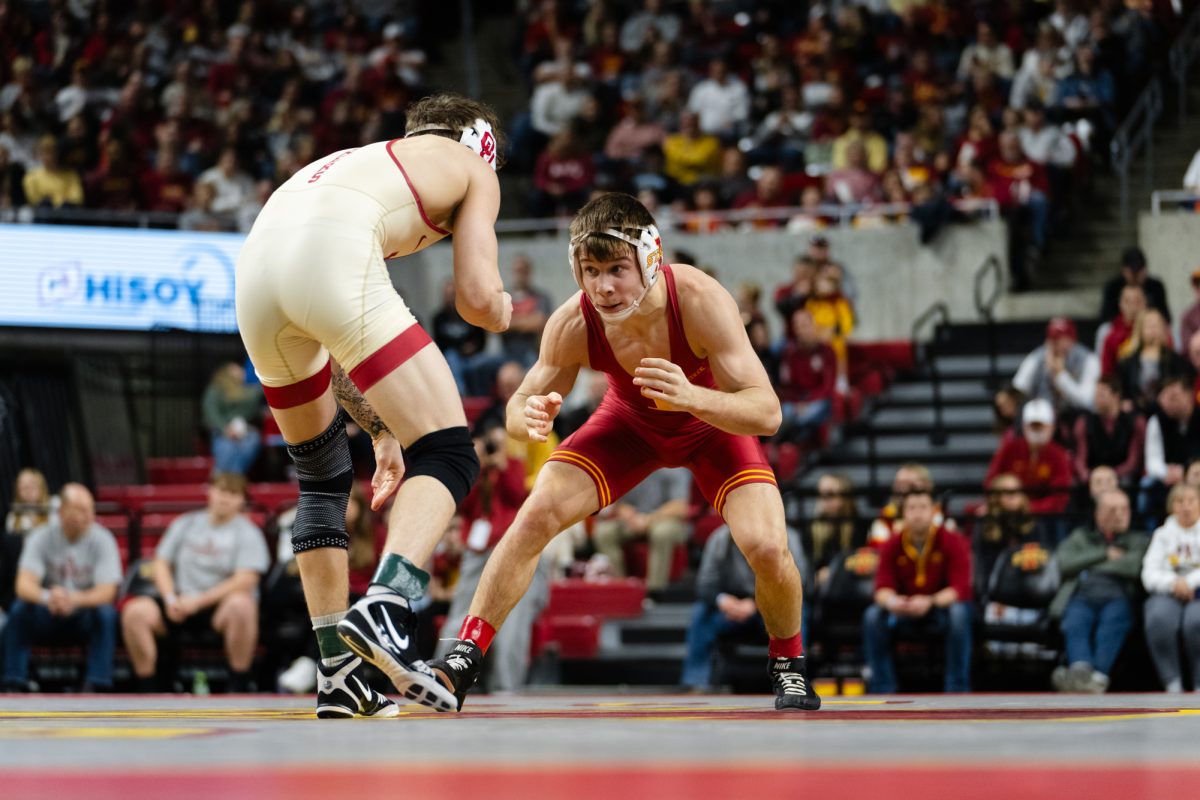From football player to cheerleader, Mitchell Knoth has dealt with the adversity
October 31, 2017
Mitchell Knoth, a sophomore on the cheerleading team, can be spotted before home football games on the sideline or at events on the tailgate lots. If not at the events, Knoth can be seen on the sideline engaging with the thousands of fans and performing cheers with the rest of his teammates.
Most people wouldn’t guess that Knoth once played football. Knoth has found something that brings him happiness after uncertainty.
A sports mindset
When Knoth was in eighth grade, he was on the wrestling team. During his 2012 season, he dislocated his right shoulder at a meet.
With his shoulder out of socket, Knoth still had to wrestle his opponent.
“I still beat him,” Knoth said while laughing. “I had to use my other arm to pin him.”
Following that meet, Knoth was out for the rest of the wrestling season with an injured shoulder. He had a MRI done on his injured shoulder, which showed he suffered a torn labrum.
It required surgery and Knoth was sidelined for six months. The injury lead him to give up wrestling permanently.
Football season approached at Batavia High School in Batavia, Illinois, a suburb of Chicago. In the fall of 2012, Knoth was unable to participate in football however he returned the following season. From the beginning he lacked the experience his fellow teammates had.
“I was super small compared to everyone because I had lost a lot of weight,” Knoth said. “I just felt out of place, too.”
Knoth also felt a disconnect with his coaches, saying that his coaches didn’t like that he was a newcomer and he had to be taught his position.
“If I had played freshman year, then they would have known me better and let me play more,” Knoth said.
Knoth lacked a connection with his teammates as well, feeling that he was looked down upon by them due to his lack of experience.
During Knoth’s struggle on the football team, he confided to his best friend and teammate, Matthew Smith. The two had been friends since seventh grade and Knoth said that Smith didn’t treat him any differently following his return back to football their sophomore year.
Smith said the injury and Knoth’s change of interests led to his unhappiness, which showed on the football field. Knoth decided to give football another chance his junior year, it didn’t last long.
“I quit because I didn’t like how I was being treated and it was a waste of my time,” Knoth said.
From football to cheerleading
During the fall of his junior year, Knoth found himself not occupied with sports. His gym teacher, who was also the high school’s dance coach, suggested Knoth try out for the cheer team. Knoth’s fellow classmate and current Iowa State sophomore Sam Guillemot said he took their teacher’s suggestion as a joke, but decided to tryout anyway. After the first day of tryouts, both Knoth and Guillemot were surprised to find they really enjoyed cheer.
The two friends made the cheer team following tryouts and the transition was different than anticipated.
“It’s really a sport where you can be good as you want to be, so it’s just a matter of pushing yourself,” Guillemot said. “It seemed to get harder for both me and Mitch [Knoth] and I think Mitch tried a little bit harder than I did.”
Knoth’s female teammates were excited that the two of them were joining because they didn’t previously have any males on the team.
“When it comes to cheer, guys are always a good thing because they bring muscle for the stunts,” Knoth said. “They’re happy to see that we’re able to help out in that aspect.”
Overall, Knoth had heard mixed responses to him doing cheerleading. He said that many of his friends outside of football were supportive of him joining the sport.
Knoth said that he felt the football team attacked him after he joined the cheerleading team.
“I remember from the football team they were like, ‘oh he quit football to become gay,'” Knoth said. “They were giving me s***.”
Knoth received support from his family after joining cheer. His family thought cheering was just a hobby at his high school and not a sport.
“They were completely foreign to the idea. They had no idea what it was,” Knoth said. “It took my dad a while to get what it was, but now he’s all about it.”
He continued cheer into his senior year of high school and after cheer season ended for his high school team, he decided to give competitive cheer a chance.
Knoth emailed the coach for the team and told the coach he wanted to try out. He received the opportunity to try out and potentially be placed on one of the team’s multiple squads.
Out of their five teams, he was placed on their fourth level.
“I thought that was probably the hardest experience I’ve ever been apart of,” Knoth said.
The one thing different about his competitive cheer squad from his school cheer team was the amount of male cheerleaders. Knoth went from being on a team with a total of two male cheerleaders to a team with a total of 13 male cheerleaders.
Knoth said that it was weird for him and he liked being one of the only males on the team.
“We got more attention [on the high school cheer team] and we were involved more,” Knoth said. “But, when it’s that many guys sometimes they didn’t even need you for stuff, whereas before I had to be in everything and help out with everything.”
He also felt out of place due to the lack of experience compared to the other male cheerleaders.
A passion at Iowa State
The weekend Iowa State was having their cheer tryouts was the same weekend Knoth was away at nationals with his competitive cheer team.
“I didn’t know that I could have tried out afterwards, or done a video tryout,” Knoth said. “So I basically gave up any thought of me being on the team because it was already past tryout day.”
At the beginning of his freshman year at Iowa State, he was recuperating from three concussions he had sustained during his time cheering.
He said he was relieved to not participate in cheer because it gave his body time to heal.
Knoth said that when it comes to cheer, most people don’t realize how physically demanding the sport can be. All the concussions he sustained were from tumbling and stunting.
“Two of [my concussions] were from landing on the back of my head,” Knoth said. “One of them was from an elbow [to the head].”
Knoth had worries about being on the Iowa State cheer team with his three previous concussions.
“If I get another one, I can’t do it anymore,” Knoth said.
Knoth currently deals with chronic headaches due to the concussions he’s received.
Six-year Iowa State head cheer coach Kelli Baker said she looks for athleticism in male cheerleaders.
“Honestly if they don’t have cheer experience, we want athletes,” Baker said. “We just look for a lot of potential.”
Baker said many of the male cheerleaders played other sports like Knoth, but there are a few where cheerleading was their main sport.
“I would say 90 percent of the guys that do cheerleading played some other sport at some point or for most of their athletic experience,” Baker said.
Iowa State has always had a coed cheerleading squad. The all girls cheer squad wasn’t introduced until the early 2000s.
“It’s been a coed sport for longer in college than it’s been a female dominated sport,” Baker said. “Before it was a coed sport, it was a mostly male dominated group of people, where you had your ‘yell leaders’ and things like that [were] mostly men.”
During dead week of Knoth’s spring semester, he decided to partake in the cheer tryouts. He called the ordeal stressful because he also had to study for his finals.
He came into tryouts with an open mind about making the team.
After making the team, Knoth realized that he was going to be more busy in the upcoming year and he didn’t go around telling people about making the team.
“People knew I tried out and if they asked how I did, I would say, ‘yeah I made it,’” Knoth said.
He didn’t make his announcement until the team roster was announced on the Iowa State Cheer’s Facebook page.
“I might as well show that I’m in it now,” Knoth said of sharing the roster announcement on his personal Facebook page.
For Baker, a former cheerleader for Iowa State, she can remember years of having 10 or 12 male cheerleaders one year and only six or eight another year.
“I would say cheerleading for males wasn’t as popular at the high school level then,” Baker said. “So there weren’t that many that came into college with that sort of experience with it.”
Baker said that All-Star cheerleading has led to a rise in popularity in high school boys participation. To a certain extent males are turning to cheerleading to possibly obtain athletic scholarships.
“There’s obviously not as many scholarship opportunity in cheerleading as other sports,” Baker said. “But I do think that they maybe see it as a way to have a college athletic experience without having to be recruited for a NCAA sport.”
Currently there are 12 male cheerleaders on the team and the majority of the males are sophomores like Knoth. Once practices began with his new team, he noticed the differences right away.
Knoth said that the male cheerleaders on his competitive cheer team were cocky and arrogant, but everyone on the Iowa State cheer team were nice and open to accepting him on the team.
“That was my first impression, everyone was super nice to me,” Knoth said. “I kind of felt I was going to become friends with everyone here and that’s how it’s been so far.”
The biggest challenge for him being on the cheer team was time management because he typically spends 30 hours a week involved with cheer.
Knoth said that every day of the week he expects something of two or more hours involving cheer.
Three days a week, Knoth has weightlifting sessions for an hour and he cheers in home football games, while alternating cheering at volleyball games and basketball games.
“I’m always doing something. I have no free time,” Knoth said.
For the three two-hour practices a week, Baker said that there aren’t distinct differences in practices and game days between male and female cheerleaders.
In practices, every cheerleader is working on stunting and tumbling. Baker said practicing cheers is a small portion of what the team does.
Now cheering at a collegiate level, Knoth said that the skill level is new compared to the previous levels of cheer because he’s doing more stunting then he did in high school.
Knoth did not have male cheer coaches in high school, but at Iowa State he has two male coaches. One of the male coaches, Darren Papka, was a part of the Iowa State co-ed cheer team in the 1990s.
“It’s great because they understand and know how it is to be, they’ve been in our shoes.” Knoth said.
The challenges of being a male cheerleader
Knoth said that he has noticed differences between his female high school and college teammates. With his high school teammates he noticed a lot of immaturity, but with his college teammates he doesn’t see that at all.
Baker said that most males have generic concerns when it comes to participating in cheerleading since it has the stigma of being a female sport. She said male cheerleaders deal with judgment on a regular basis from those outside of cheer.
“I get made fun of a good amount, but it’s just because people are ignorant,” Knoth said.
Knoth said that when he first arrived at Iowa State and would tell people that he was a male cheerleader in high school, people gave him a hard time and would question his “manliness.”
Baker said that the community can have a negative response towards the male cheerleaders. She remembers times where the male cheerleaders receive comments from people saying they wouldn’t purchase items from the cheer team’s fundraiser because they were males.
Baker said that Knoth has expressed that he has encountered the treatment before during his fundraising efforts.
“It’s usually just ignorant comments like that, that are from people probably not in the best state of mind before a game,” Baker said.
For the most part, she believes that there’s a positive reception from the community towards the male cheerleaders.
“When [male cheerleaders] are holding up a girl with one arm, people are impressed by that, regardless of their preconceived notions are,” Baker said.
Baker said that she can see an increase in more male cheerleaders in the next 5-10 years.
“I think it is on a steady rise,” Baker said. “I’ve already seen it just enough in the last few years of getting more emails of interest from high school males.”
Baker said that in the past it was girls on the cheer team bringing their guy friends with no prior experience or interest to open gyms. The stigma of male cheerleaders being homosexual is still there.
“I think a lot of those stigmas will still always be there,” Baker said. “Just with anything people think that is supposed to be a traditional way and there are people who challenge that and there’s always going to be a certain population that kind of questions whether that fits the norms or not.”
Baker said that cheerleading has the most diverse groups of participants. The sport is a rare sport where the diversity in people do not apply and are celebrated and accepted more than other sports.
“There can be a mixture of heterosexual people or homosexual people or come from this background or that background, or this race or socioeconomic status,” Baker said. “I think it’s kind of one of those sports that doesn’t really have norms.”
For Knoth’s two younger brothers, he thinks that the two youngsters secretly think it’s cool what Knoth does.
“They’ve seen me on ESPN,” Knoth said.
Knoth said that cheerleading has made him more open to what other peoples hobbies and activities are.
“I’ve been stereotyped and I don’t want to be stereotyped by anyone else.” Knoth said. “I never would have thought that I would be where I am now.”


